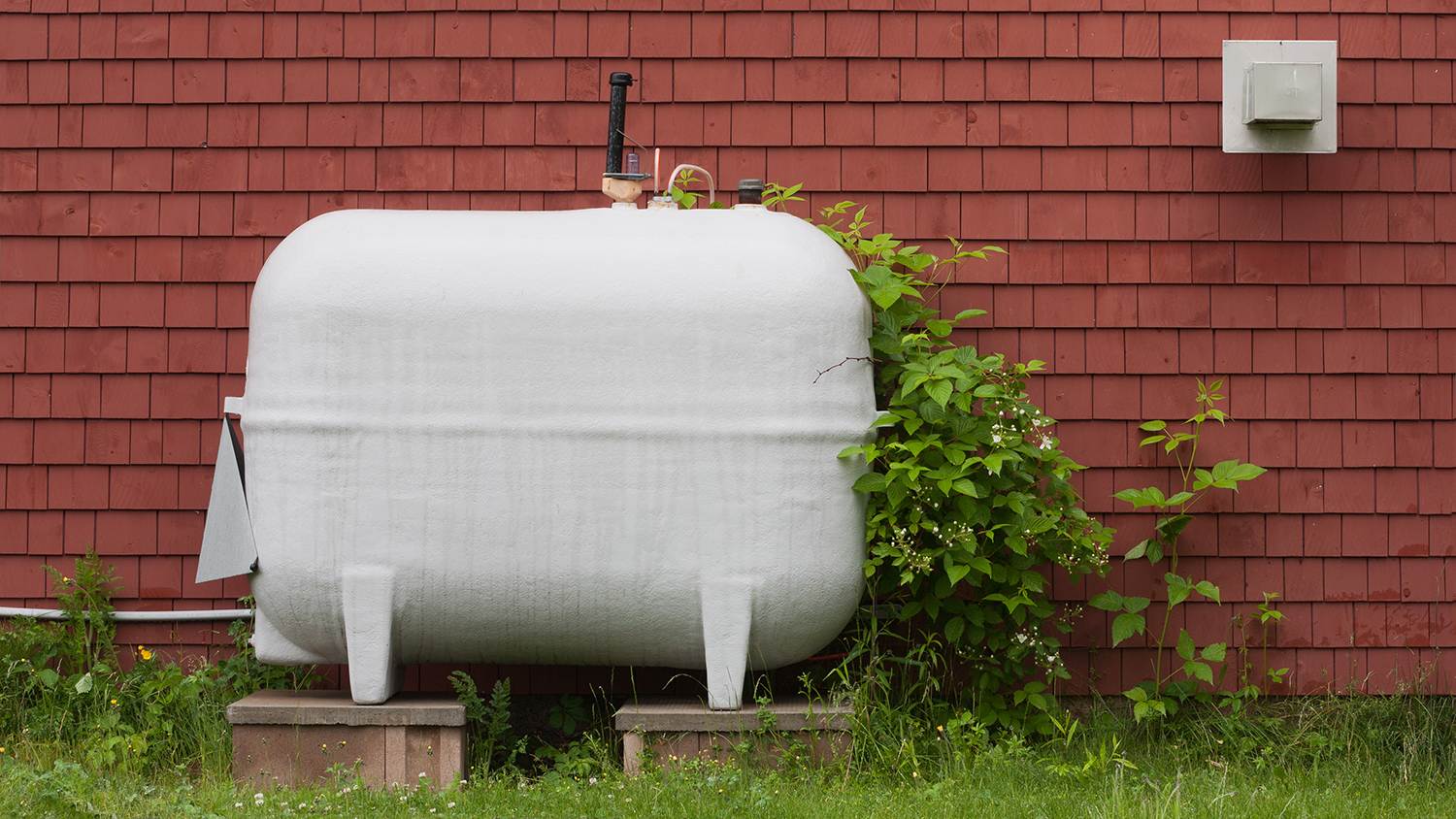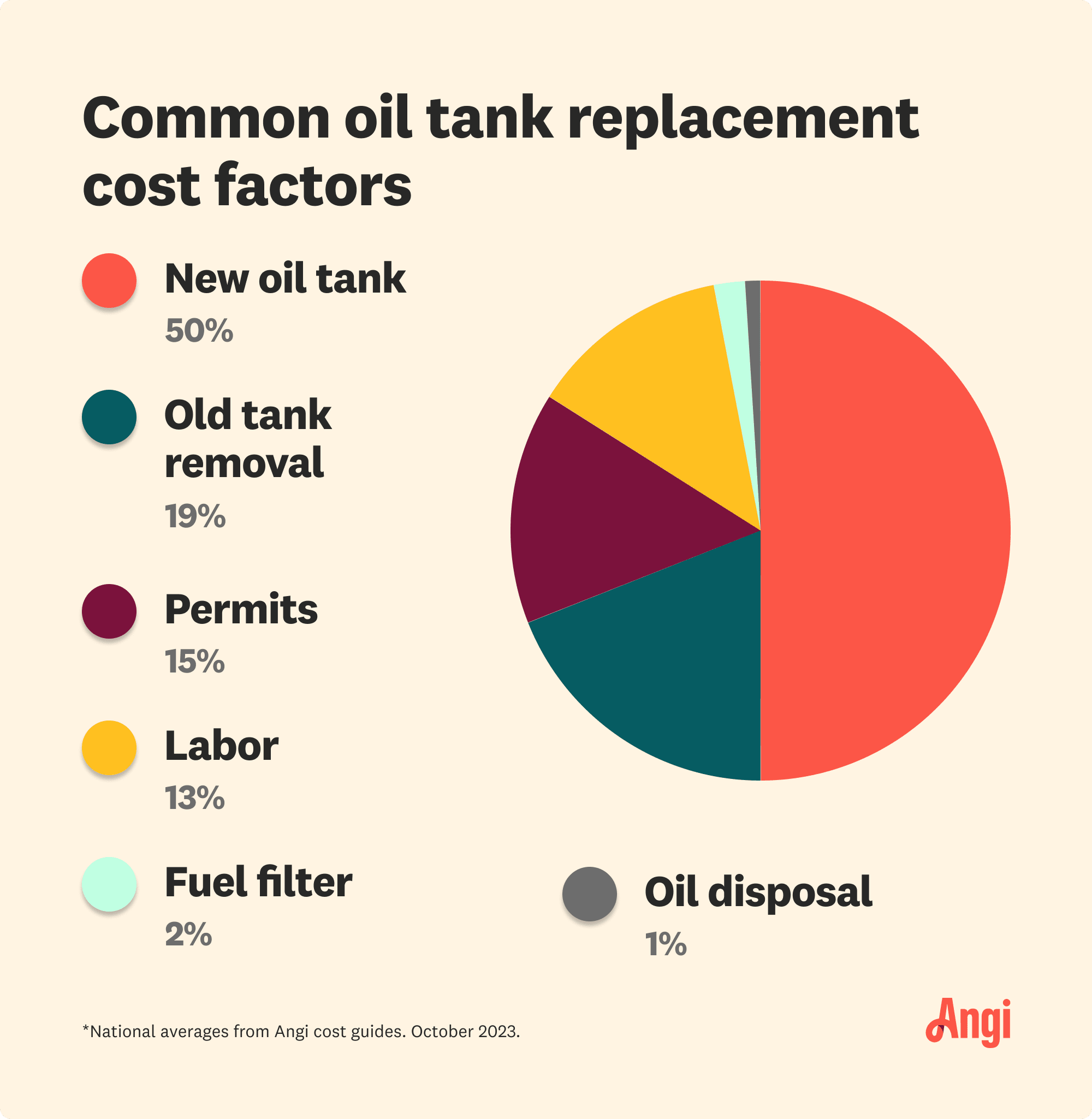
If your air conditioner won’t turn on or makes chattering noises, you might have a bad contactor. Learn more about AC contactor replacement costs in this guide.
Heating and air conditioning service costs depend on your project and location. Check with a local pro for your specific job.
Oil tank replacement costs an average of $2,400, with prices often ranging from $1,200 to $4,600.
If you have an aboveground oil tank, expect to pay $1,200–$2,500 for an outdoor unit and $550–$3,000 for an indoor one.
An underground oil tank is the most expensive option, averaging $1,600–$4,600.
Other factors affecting oil tank replacement cost include the size of the tank, labor rates, removal of the old tank, location, and more.
Oil tank replacement cost falls anywhere between $400 and $6,500. If your home uses oil heat, you have an oil tank somewhere on your property to store the oil. Oil tanks only last 10 to 30 years, so you will have to replace them at some point.
The average cost of an oil tank replacement is $2,400. The typical range is anywhere from $1,200 to $4,600 depending on the size of the tank and whether you get an indoor, aboveground, or underground installation.
The type of oil tank you need depends on where the tank is designed to be housed. Here’s a breakdown of how the location of your oil tank affects the replacement cost:
| Tank Type | Average Cost |
|---|---|
| Aboveground outdoor tank | $1,200–$2,500 |
| Underground tank | $1,600–$4,600 |
| Aboveground indoor tank | $550–$3,000 |
An outdoor aboveground oil tank is the mid-range option in terms of cost. The cost is between $1,200 and $2,500. You will have to do extras like installing a concrete base, but you won't have to dig a hole for the oil tank to live in.
An underground tank is the most expensive option because it can cost an extra $1,000 to $2,000 to create an access hole for the tank.
Starting at just $550, indoor tank removal is your least-expensive option because you won't have to create an access hole or build a concrete slab since your basement's floor should suffice.

The factors affecting the price of an oil tank replacement include the size of the oil tank and the type of installation.

Roughly $500 to $1,200 of your budget will go toward labor. You’ll pay in the lower range if installing the oil tank in the basement since that doesn’t require much work.
Oil tanks range from around 100 to over 1,000 gallons, and the larger the oil tank you choose, the more it will cost. The price is also affected by whether the tank is a single-walled or double-walled tank. This feature impacts the tank’s longevity and susceptibility to corrosion.
Here’s a breakdown of oil tank replacement costs based on size:
| Capacity (Gallons) | Single-Wall Cost | Double-Wall Cost |
|---|---|---|
| 100–250 | $300–$2,200 | $900–$3,800 |
| 250–500 | $1,000–$2,100 | $1,200–$5,300 |
| 500–700 | $1,000–$4,900 | $3,000–$8,500 |
| 1000+ | $2,800–$5,200 | $5,100–$9,700 |
If you get an indoor installation, you'll pay on the lower end since you won't have to build access holes or a concrete slab. An underground installation that requires digging will cost at the highest end. An aboveground option is a mid-range solution.
A smaller factor is whether you need to replace the fuel filters and fuel fill pipe, which will add about $100 to $150 to the price.
Oil tank removal costs between $400 and $3,000 before factoring in the replacement costs. Expect to pay an average of $1,700 for oil tank removal—as long as there isn't an environmental issue lurking under the surface of your soil. A tank buried in the ground could reach as high as $3,000.
You may find differences in oil tank replacement costs based on where you live in the U.S. Buried oil tanks are less common in western portions of the U.S. than in the eastern part of the country. So, homeowners may spend more simply because there’s higher demand for removal and replacement in states like Massachusetts, Rhode Island, and Connecticut compared to states like California, Oregon, or Washington.
Here’s a breakdown of oil tank replacement costs by location:
| Region | Average Cost |
|---|---|
| Northeast | $1,900–$4,025 |
| Midwest | $1,650–$2,000 |
| South | $1,500–$1,700 |
| West | $1,700–$2,100 |
While the type and size of the tank and labor all play major roles in the cost to replace an oil tank, there are other factors that can influence how much you’ll pay for this project. From paying for permits to removing oil or sludge, here are some additional things you may need to budget for.
Most cities require a permit to replace your oil tank. Obtain the proper documents or have your pro help you. Building permits cost an average of $1,330 nationally but will vary greatly depending on where you live and your specific project.
Have your contractor extract the reusable oil—if any—from your tank to avoid letting costly gallons go to waste. Pumping this oil requires special equipment to extract, filter, and reuse, so you may incur extra costs. Other contractors might want to keep it and reimburse you by discounting your bill.
Similar to oil tank removal fees, your contractor will likely price waste disposal by pound or ounce. While end rates vary by town and city, you might pay between $10 and $70, including service fees to remove and dispose of sludge properly.
If you live in a colder climate, for example, you might opt for insulated fuel lines to keep your fuel from freezing. Your contractor might recommend a different supply line depending on your climate and location.
Replacing an oil tank is not a DIY job. It is a specialized and potentially hazardous task that involves compliance with regulations, safety precautions, and environmental considerations. If you’re trying to figure out how to cut costs without doing the job yourself, however, there are a few things you can do.
Install the tank indoors: While you may have originally intended to install the oil tank outside underground or above ground, basement installs are more affordable because you won't have to dig a hole or install a concrete slab.
Get a smaller tank: In this case, bigger tanks mean more money. If you can swing it, opt for a smaller tank that’s easier to install.
Be flexible regarding access: If you need to create an access hole for your tank, consider cutting into the wall of your home rather than into the foundation, which could save you around $1,000.
If you hire an HVAC company near you to replace the oil tank, you can expect to pay between $500 to $1,200 for labor. It’s vital to hire a pro for this task because it can be hazardous and difficult to install correctly.
Oil tank installations are complex and have strict regulations, so here’s why you should hire a pro:
Oil tanks are highly flammable, and pros have the expertise and equipment to handle the job safely.
Professionals comply with environmental regulations to ensure the tank is installed correctly and the old tank is properly disposed of.
Pros have extensive training that allows them to work with complex plumbing and heating systems.
The pros check the system for potential issues and ensure it is secure.
Reputable pros will warranty their work, materials, and carry insurance.
Home is the most important place on earth, which is why Angi has helped more than 150 million homeowners transform their houses into homes they adore. To help homeowners with their next project, Angi provides readers with the most accurate cost data and upholds strict editorial standards. We extensively research project costs to develop the pricing data you see, so you can make the best decisions for you and your home. We rely on reputable sources, including the U.S. Bureau of Labor Statistics, academic journals, market studies, and interviews with industry experts—all to ensure our prices reflect real-world projects.
Want to help us improve our cost data? Send us a recent project quote to [email protected]. Quotes and personal information will not be shared publicly.
From average costs to expert advice, get all the answers you need to get your job done.

If your air conditioner won’t turn on or makes chattering noises, you might have a bad contactor. Learn more about AC contactor replacement costs in this guide.

The average cost of an electric furnace ranges between $1,700 and $7,000, depending on the size, ductwork, and complexity.

The cost of a new AC unit depends on the size and type. Our guide breaks down AC replacement cost factors so you can decide which option matches your budget.

There are a few different types of refrigerant for AC systems, but some contain environmental hazards. Learn about the five main types of refrigerant.

Figuring out how to eliminate ductwork noise may require anything from replacing the ducts to changing the filter. Learn more about fixing this issue.

Learning how to secure a window AC unit will avoid personal injury and damage to your home. It will also protect against theft and break-ins.